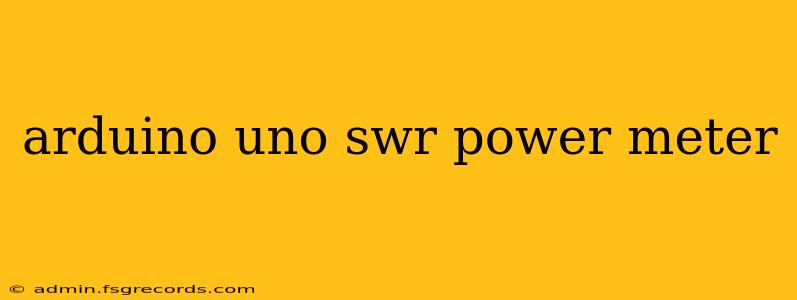Building a simple and effective SWR (Standing Wave Ratio) power meter using an Arduino Uno is a rewarding project for amateur radio enthusiasts and electronics hobbyists. This guide provides a detailed walkthrough, covering the necessary components, circuit design, Arduino code, and calibration procedures. Understanding SWR is crucial for efficient radio transmission, minimizing signal loss and protecting your equipment. This project offers a cost-effective alternative to commercially available SWR meters, allowing for hands-on learning and customization.
Understanding SWR and its Importance
SWR represents the ratio of the maximum to minimum voltage along a transmission line. An ideal SWR of 1:1 indicates perfect impedance matching between your transmitter and antenna. High SWR values (e.g., 2:1 or higher) signify a mismatch, leading to several problems:
- Reduced power transmission: A significant portion of your transmitted power is reflected back towards the transmitter, reducing the effective power reaching the antenna.
- Overheating of transmitter components: Reflected power can overheat the final amplifier stage of your transmitter, potentially causing damage.
- Reduced antenna efficiency: Mismatched impedance reduces the antenna's ability to radiate effectively.
Regular SWR checks are essential for maintaining optimal radio performance and protecting your valuable equipment.
Components Required for Your Arduino SWR Power Meter
This project utilizes readily available components, making it easily accessible. You'll need:
- Arduino Uno: The microcontroller that will process the sensor data.
- Directional Coupler: This crucial component samples a small portion of the forward and reflected power. Choose a coupler appropriate for your operating frequency range and power level. Many different types and designs exist, so select one that matches your needs.
- Power Meter IC: An RF power sensor IC, like the AD8307, is ideal for measuring the power levels sampled by the directional coupler. This provides analog readings proportional to the power.
- Resistors: Several resistors will be needed for proper biasing and signal conditioning of the power sensor IC. Their values will depend on the specific IC used. Refer to the datasheet for the correct values.
- Capacitors: Capacitors will be used for filtering and decoupling.
- Breadboard: For prototyping the circuit.
- Jumper Wires: For connecting the components.
- USB Cable: For connecting the Arduino to your computer.
- Display (Optional): An LCD or OLED display can provide real-time SWR and power readings.
Circuit Diagram and Explanation
(A detailed circuit diagram would be included here if this were a visual medium. A textual description follows instead.)
The directional coupler divides the RF signal into forward and reflected components. These are then fed into two separate power meter ICs. Each IC outputs an analog voltage proportional to the power level. The Arduino reads these voltages via its analog input pins. The Arduino then processes these readings to calculate the SWR using the formula: SWR = (1 + √(Reflected Power / Forward Power)) / (1 - √(Reflected Power / Forward Power)). The result is then displayed on the chosen output, whether it's a serial monitor or an LCD. Appropriate resistors and capacitors are used for proper signal conditioning and to filter out noise. Careful attention must be paid to the grounding of the circuit to minimize interference.
Arduino Code
(The Arduino code would be included here. It would require libraries for the specific display used, if any. The code would incorporate the SWR calculation formula mentioned above and handle the analog readings from the power sensor ICs.) A placeholder comment is used below to indicate where this code would go:
// Arduino code for SWR power meter would be placed here. This would include initialization, reading analog inputs, calculating SWR, and displaying results.
Calibration and Testing
Accurate calibration is vital for reliable readings. This typically involves using a known power source and adjusting the code or circuit to match the readings. Refer to the datasheets for your directional coupler and power sensor ICs for specific calibration procedures. Testing should be done with caution, ensuring the correct safety measures are in place given that you are working with RF power.
Safety Precautions
Working with RF signals requires careful attention to safety. Always follow these guidelines:
- Never expose yourself to high levels of RF radiation. Keep a safe distance from the antenna and transmitter during operation.
- Use appropriate safety equipment. This may include RF safety glasses and appropriate grounding.
- Turn off the transmitter when not in use.
- Consult safety regulations and guidelines relevant to your operating frequency and power levels.
This guide provides a foundation for constructing an Arduino-based SWR power meter. Remember that the specifics of the components and code may need adjustments based on your chosen hardware and desired accuracy. Thorough research and careful attention to detail are crucial for a successful build and safe operation. Always consult the datasheets for all components used.

